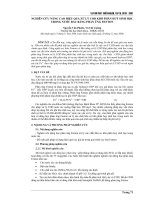Ứng dụng Polyester phân hủy sinh học trong dược phẩm và môi trường
Bạn đang xem bản rút gọn của tài liệu. Xem và tải ngay bản đầy đủ của tài liệu tại đây (246.27 KB, 16 trang )
Macromol. Rapid Commun. 21, 117–132 (2000)
117
Biodegradable polyesters for medical and ecological
applications
Yoshito Ikada*
1
, Hideto Tsuji
2
1
Suzuka University of Medical Science, 1001-1 Kishioka-cho, Suzuka, Mie 510-0293, Japan
2
Department of Ecological Engineering, Faculty of Engineering, Toyohashi University of Technology,
Tempaku-cho, Toyohashi, Aichi 441-8580, Japan
(Received: June 9, 1999; revised: August 19, 1999)
1. Introduction
Polymer degradation takes place mostly through scission
of the main chains or side-chains of polymer molecules,
induced by their thermal activation, oxidation, photolysis,
radiolysis, or hydrolysis. Some polymers undergo degra-
dation in biological environments when living cells or
microorganisms are present around the polymers. Such
environments include soils, seas, rivers, and lakes on the
earth as well as the body of human beings and ani-
mals
1–18)
. In this article, biodegradable polymers are
defined as those which are degraded in these biological
environments not through thermal oxidation, photolysis,
or radiolysis but through enzymatic or non-enzymatic
hydrolysis.
In a strict sense, such polymers that require enzymes
of microorganisms for hydrolytic or oxidative degrada-
tion are regarded as biodegradable polymers. This defi-
nition does not include polylactides in the category of
biodegradable polymers, because polylactides are
hydrolyzed at a relatively high rate even at room tem-
perature and neutral pH without any help of hydrolytic
enzymes if moisture is present. This often gives rise to
confusion when we say that polylactides are biodegrad-
able. As will be shown later, polylactides, especially
polyglycolide, are readily hydrolyzed in our body to the
respective monomers and oligomers that are soluble in
aqueous media
2)
. As a result, the whole mass of the
polymers disappears, leaving no trace of remnants.
Generally, such a polymer that loses its weight over
time in the living body is called an absorbable, resorb-
able, or bioabsorbable polymer as well as a biodegrad-
able polymer, regardless of its degradation mode, in
other words, for both enzymatic and non-enzymatic
hydrolysis. To avoid this confusion, some people insist
that the term “biodegradable” should be used only for
such ecological polymers that have been developed
aiming at the protection of earth environments from
plastic wastes, while the polymers applied for medical
purposes by implanting in the human body should not
be called biodegradable but resorbable or absorbable. In
this article, however, the term “biodegradable” is used
in spite of this confusion, since the term has been
widely utilized in the biomaterial world for the biome-
dical polymers that are absorbed in the body even
Review: Numerous biodegradable polymers have been
developed in the last two decades. In terms of application,
biodegradable polymers are classified into three groups:
medical, ecological, and dual application, while in terms
of origin they are divided into two groups: natural and
synthetic. This review article will outline classification,
requirements, applications, physical properties, biode-
gradability, and degradation mechanisms of representative
biodegradable polymers that have already been commer-
cialized or are under investigation. Among the biodegrad-
able polymers, recent developments of aliphatic poly-
esters, especially polylactides and poly(lactic acid)s, will
be mainly described in the last part.
Macromol. Rapid Commun. 21, No. 3 i WILEY-VCH Verlag GmbH, D-69451 Weinheim 2000 1022-1336/2000/0302–0117$17.50+.50/0
Polarizing optical photomicrograph of a PLLA film annealed
at 140 8C after melting at 200 8C
118
Y. Ikada, H. Tsuji
through non-enzymatic hydrolysis. In other words, the
term “biodegradable” is used here in broad meaning
that the polymer will eventually disappear after intro-
duction in the body, without references to the mechan-
isms of degradation. Fig. 1 shows a variety of mechan-
isms responsible for polymer resorption.
These biodegradable polymers have currently two
major applications; one is as biomedical polymers that
contribute to the medical care of patients and the other is
as ecological polymers that keep the earth environments
clean. Most of the currently available biodegradable poly-
mers are used for either of the two purposes, but some of
them are applicable for both, as illustrated in Fig. 2. Bio-
degradable polymers can be also classified on the basis of
the origin, that is, naturally occurring or synthetic. Tab. 1
lists biodegradable polymers classified according to the
polymer origin.
The purpose of this article is to give a brief overview
on representative biodegradable polymers that have
Fig. 1. Modes of resorption of polymers
Tab. 1. Classification of biodegradable polymers
Natural Polymers Synthetic Polymers
Sub-classification Examples Sub-classification Examples
1. Plant origin 1. Aliphatic polyesters
1.1 Polysaccharides Cellulose, Starch, Alginate 1.1 Glycol and dicarbonic acid
polycondensates
Poly(ethylene succinate),
Poly(butylene terephthalate)
2. Animal origin 1.2 Polylactides Polyglycolide, Polylactides
2.1 Polysaccharides Chitin (Chitosan), Hyaluronate 1.3 Polylactones Poly(e-carpolactone)
1.4 Miscellaneous Poly(butylene terephthalate)
2.2 Proteins Collagen (Gelatin), Albumin 2. Polyols Poly(vinyl alcohol)
3. Microbe origin 3. Polycarbonates Poly(ester carbonate)
3.1 Polyesters Poly(3-hydroxyalkanoate)
3.2 Polysaccharides Hyaluronate 4. Miscellaneous Polyanhydrides,
Poly(a-cyanoacrylate)s,
Polyphosphazenes,
Poly(orthoesters)
Fig. 2. Application of biodegradable polymers. PAA: Poly-
(acid anhydride); PBS: Poly(butylene succinate); PCA: Poly(a-
cyanoacrylate); PCL: Poly(e-caprolactone); PDLLA: Poly(
DL
-
lactide), Poly(
DL
-lactic acid); PEA: Poly(ester amide); PEC:
Poly(ester carbonate); PES: Poly(ethylene succinate); PGA:
Poly(glycolide), Poly(glycolic acid); PGALA: Poly(glycolide-
co-lactide), Poly(glycolic acid-co-lactic acid); PHA: Poly(hy-
droxyalkanoate); PHB: Poly(3-hydroxybutyrate); PLLA:
Poly(
L
-lactide), Poly(
L
-lactic acid); POE: Poly(orthoester)
Biodegradable polyesters for medical and ecological applications
119
already been commercialized or are under investigation
for biomedical and ecological applications.
2. Biomedical applications
2.1 Biomaterials
A variety of polymers have been used for medical care
including preventive medicine, clinical inspections, and
surgical treatments of diseases
19–23)
. Among the polymers
employed for such medical purposes, a specified group of
polymers are called polymeric biomaterials when they
are used in direct contact with living cells of our body.
Typical applications of biomaterials in medicine are for
disposable products (e.g. syringe, blood bag, and cathe-
ter), materials supporting surgical operation (e.g. suture,
adhesive, and sealant), prostheses for tissue replacements
(e.g. intraocular lens, dental implant, and breast implant),
and artificial organs for temporary or permanent assist
(e.g. artificial kidney, artificial heart, and vascular graft).
These biomaterials are quite different from other non-
medical, commercial products in many aspects. For
instance, neither industrial manufacturing of biomaterials
nor sale of medical devices are allowed unless they clear
strict governmental regulatory issues. The minimum
requirements of biomaterials for such governmental
approval include non-toxicity, sterilizability, and effec-
tiveness, as shown in Tab. 2. Biocompatibility is highly
desirable but not indispensable; most of the clinically
used biomaterials lack excellent biocompatibility,
although many efforts have been devoted to the develop-
ment of biocompatible materials by biomaterials scien-
tists and engineers. A large unsolved problem of bioma-
terials is this lack of biocompatibility, especially when
they are used not temporarily but permanently as
implants in our body. Low effectiveness is another pro-
blem of currently used biomaterials.
The biological materials composing our living body as
skeleton, frame, and tissue matrix are all biodegradable in
a strict sense and gradually lose the mass unless addi-
tional treatments are given when our heart ceases beating.
Recently, biodegradable medical polymers have
attracted much attention
7, 10,22)
. There are at least two rea-
sons for this new trend. One is the difficulty in develop-
ing such biocompatible materials that do not evoke any
significant foreign-body reactions from the living body
when receiving man-made biomaterials. At present we
can produce biomaterials that are biocompatible if the
contact duration of biomaterials with the living body is as
short as several hours, days, or weeks
24)
. However, the
science and technology of biomaterials have not yet
reached such a high level that allows us to fabricate bio-
compatible implants for permanent use. On the contrary,
biodegradable polymers do not require such excellent
biocompatibility since they do not stay in our body for a
long term but disappear without leaving any trace of for-
eign materials.
The other reason for biodegradable polymers attracting
much attention is that nobody will want to carry foreign
materials in the body as long-term implants, because one
cannot deny a risk of infection eventually caused by the
implants.
Although biodegradable polymers seem very promising
in medical applications, these kinds of polymers currently
do not enjoy large clinical uses, because there is a great
concern on biodegradable medical polymers. This con-
cern is the toxicity of biodegradation by-products, since
the causes of toxicity of biomaterials are mostly due to
low-molecular-weight compounds that have leached from
the biomaterials into the body of patients. They include
monomers remaining unpolymerized, ethylene oxide
remaining unremoved, additives such as anti-oxidant and
pigments, and fragments of polymerization initiator and
catalyst. The content of these compounds in currently
used biomaterials is below the level prescribed by regula-
tions. Water-insoluble polymers generally are not able to
physically and chemically interact with living cells unless
the material surface has very sharp projections or a high
density of a cationic moiety
24)
.
However, biodegradable polymers always release low-
molecular-weight compounds into the outer environment
as a result of degradation. If they can interact with the
cell surface or enter into the cell interior, it is possible
that the normal condition of the cell is disturbed by such
foreign compounds. One can say that an implanted bio-
material induces cyto-toxicity if this disturbance is large
enough to bring about an irreversible damage to the cell.
Purified polyethylene and silicone are not toxic but also
not biocompatible, because thrombus formation and
encapsulation by collagenous fibrous tissues take place
around their surface when implanted
24)
. The largest differ-
ence in terms of toxicity between biodegradable and non-
biodegradable polymers is that biodegradable polymers
inevitably yield low-molecular-weight compounds that
might adversely interact with living cells while any leach-
Tab. 2. Minimal requirements of biomaterials
1. Non-toxic (biosafe)
Non-pyrogenic, Non-hemolytic, Chronically
non-inflammative, Non-allergenic, Non-carcinogenic,
Non-teratogenic, etc.
2. Effective
Functionality, Performance, Durability, etc.
3. Sterilizable
Ethylene oxide, c-Irradiation, Electron beams, Autoclave,
Dry heating, etc.
4. Biocompatible
Interfacially, Mechanically, and Biologically
120
Y. Ikada, H. Tsuji
ables or extractables eventually contaminating non-biode-
gradable polymers can be reduced to such a low level as
required by governmental regultaions, if the polymers are
extensively and carefully manufactured and purified.
2.2 Surgical use
Application of biodegradable polymers to medicine did
not start recently and has already a long history. Actual
and possible applications of biodegradable polymers in
medicine are shown in Tab. 3. Tab. 4 lists representative
synthetic biodegradable polymers currently used or under
investigation for medical application. As is seen, most of
the applications are for surgery. The largest and longest
use of biodegradable polymers is for suturing. Collagen
fibers obtained from animal intestines have been long
used as absorbable suture after chromium treatment
6)
.
The use of synthetic biodegradable polymers for suture
started in USA in the 1970’s
2, 7)
. Commercial polymers
used for this purpose include polyglycolide, which is still
the largest in volume production, together with a glyco-
lide-
L
-lactide (90:10) copolymer
2, 7)
. The sutures made
from these glycolide polymers are of braid type processed
from multi-filaments, but synthetic absorbable sutures of
mono-filament type also at present are commercially
available.
The biodegradable polymers of the next largest con-
sumption in surgery are for hemostasis, sealing, and adhe-
sion to tissues
25)
. Liquid-type products are mostly used
for these purposes. Immediately after application of a
liquid to a defective tissue where hemostasis, sealing, or
adhesion is needed, the liquid sets to a gel and covers the
defect to stop bleeding, seal a hole, or adhere two sepa-
rated tissues. As the gelled material is no longer neces-
sary after healing of the treated tissue, it should be biode-
gradable and finally absorbed into the body. The bioma-
terials used to prepare such liquid products include fibri-
nogen (a serum protein), 2-cyanoacrylates, and a gelatin/
resorcinol/formaldehyde mixture.
2-Cyanoacrylates solidify upon contact with tissues as
a result of polymerization to polymers that are hydrolyz-
able at room temperature and neutral pH, but yield for-
maldehyde as a hydrolysis by-product
2)
. Regenerated
collagen is also used as a hemostatic agent in forms of
fiber, powder, and assemblies.
Another possible application of biodegradable poly-
mers is the fixation of fractured bones. Currently, metals
are widely used for this purpose in orthopaedic and oral
surgeries in the form of plates, pins, screws, and wires,
but they need removal after re-union of fractured bones
by further surgery. It would be very beneficial to patients
if these fixation devices can be fabricated using biode-
gradable polymers because there would be no need for a
re-operation. Attempts to replace the metals with biode-
gradable devices have already started, as will be
described later.
2.3 Pharmaceutical use
In order to deliver drugs to diseased sites in the body in a
more effective and less invasive way, a new dosage form
technology, called drug delivery systems (DDS), started
in the late 1960’s in the USA using polymers. The objec-
tives of DDS include sustained release of drugs for a
Tab. 3. Medical applications of bioabsorbable polymers
Function Purpose Examples
Bonding Suturing Vascular and intestinal
anastomosis
Fixation Fractured bone fixation
Adhesion Surgical adhesion
Closure Covering Wound cover,
Local hemostasis
Occlusion Vascular embolization
Separation Isolation Organ protection
Contact inhibition Adhesion prevention
Scaffold Cellular proliferation Skin reconstruction,
Blood vessel reconstruction
Tissue guide Nurve reunion
Capsulation Controlled drug
delivery
Sustained drug release
Tab. 4. Representative synthetic biodegradable polymers currently used or under investigation for medical application
Polymers Structure
M
w
kD
Degradation rate Medical application
Poly(glycolide) Crystalline – 100% in 2–3 months Suture, Soft issue anaplerosis
Poly(glycolic acid-co-
L
-lactic acid) Amorphous 40–100 100% in 50–100 days Suture, Fracture fixation, Oral implant,
Drug delivery microsphere
Poly(
L
-lactide) Semicrystalline 100–300 50% in 1–2 years Fracture fixation,
Ligament augmentation
Poly(
L
-lactic acid-co-e-caprolactone) Amorphous 100–500 100% in 3–12 months Suture, Dural substitute
Poly(e-caprolactone) Semicrystalline 40–80 50% in 4 years Contraceptive delivery implant,
Poly(p-dioxanone) Semicrystalline – 100% in 30 weeks Suture, Fracture fixation
Poly(orthoester) Amorphous 100–150 60% in 50 weeks
(saline, 37 8C)
Contraceptive delivery implant
Biodegradable polyesters for medical and ecological applications
121
desired duration at an optimal dose, targeting of drugs to
diseased sites without affecting healthy sites, controlled
release of drugs by external stimuli, and simple delivery
of drugs mostly through skin and mucous membranes.
Polymers are very powerful for this new pharmaceutical
technology. If a drug is administered through a parenteral
route like injection, the polymer used as a drug carrier
should be preferably absorbable, because the polymer is
no longer required when the drug delivery has been
accomplished. Therefore, biodegradable polymers are
widely used, especially for the sustained release of drugs
through administration by injection or implantation into
the body. For this purpose, absorbable nanospheres,
microspheres, beads, cylinders, and discs are prepared
using biodegradable polymers
26–28)
. The shape of the most
widely used drug carriers is a microsphere, which incor-
porates drugs and releases them through physical diffu-
sion, followed by resorption of the microsphere material.
Such microspheres can be prepared with a solvent-eva-
poration method using glycolide-lactide copolymers.
Naturally occurring biodegradable polymers are also
used as drug carriers for a sustained release of drugs. If
the drug carrier is soluble in water, the polymer need not
to be biodegradable, because this polymer will be
excreted from the body, associated with urine or feces
although excretion will take a long time if the molecular
weight of the polymer is extremely high.
2.4 Use for tissue engineering
Tissue engineering is an emerging technology to create
biological tissues for replacements of defective or lost tis-
sues using cells and cell growth factors
23)
. Also, scaffolds
are required for tissue construction if of the lost part of the
tissue is so large that it cannot be cured by conventional
drug administration. At present, such largely diseased tis-
sues and organs are replaced either with artificial organs or
transplanted organs, but both of the therapeutic methods
involve some problems. As mentioned earlier, the biocom-
patibility of clinically used artificial organs is mostly not
safisticatory enough to prevent severe foreign-body reac-
tions and to fully perform the objective of the artificial
organs aimed for patients. The biofunctionality of current
artificial organs is still poor. On the contrary, the biofunc-
tionality of transplanted organs is as excellent as healthy
human organs, but the patients with transplanted organs
are suffering from side-effects induced by immuno-sup-
presive drugs administered. Another major problem of
organ transplantation is shortage of organ donors.
The final objective of tissue engineering is to solve
these problems by providing biological tissues and organs
that are more excellent in both biofunctionality and bio-
compatibility than the conventional artificial organs.
Biodegradable polymers are required to fabricate scaf-
folds for cell proliferation and differentiation which result
in tissue regeneration or construction
23)
. Biodegradable
polymers are necessary also for a sustained release of
growth factors at the location of tissue regeneration. Gen-
erally, scaffolds used in tissue engineering are porous and
three-dimentional to encourage infiltration of a large
number of cells into the scaffolds
14)
. Currently, the poly-
mers used for scaffolding include collagen, glycolide-lac-
tide copolymers, other copolymers of lactide, and cross-
linked polysaccharides.
3. Ecological applications
3.1 Processing of plastic wastes
The other major application of biodegradable polymers is
in plastic industries to replace biostable plastics for main-
taining our earth environments clean.
The first choice for processing of plastic wastes is
reuse, but only some plastic products can be re-used after
adequate processing, and many of them are very difficult
to recycle. In these cases, wastes are processed by landfill
or incineration, but these processes often pollute the
environments. If biodegradation by-products do not exert
adverse effects on animals and plants on the earth, biode-
gradable plastics can be regarded as environment-friendly
or ecological materials. Therefore, much attention has
been focused on manufacturing biodegradable plastics
which, however, should address several requirements.
They are to be low in product cost, satisfactory in
mechanical properties, and not harmful to animals and
plants when biodegraded. The biodegradation kinetics are
also an important issue of biodegradable plastics.
Expected applications of biodegradable polymers in
plastic industries are listed in Tab. 5. As can be seen, the
applications cover a wide range of industries including
agriculture, fishery, civil engineering, construction, out-
Tab. 5. Ecological applications of biodegradable polymers
Application Fields Examples
Industrial
applications
Agriculture, Forestry Mulch films, Temporary
replanting pots, Delivery
system for fertilizers
and pesticides
Fisheries Fishing lines and nets,
Fishhooks, Fishing gears
Civil engineering and
construction industry
Forms, Vegetation nets and
sheets, Water retention sheets
Outdoor sports Golf tees, Disposable plates,
cups, bags, and cutlery
Composting Food package Package, Containers,
Wrappings, Bottles, Bags,
and Films, Retail bags,
Six-pack rings
Toiletry Diapers, Feminine hygiene
products
Daily necessities Refuge bags, Cups
122
Y. Ikada, H. Tsuji
door leisure, food, toiletry, cosmetics, and other consumer
products. It is possible that the waste left as a result of
outdoor activity and sports will stay for a long time in
natural environments, possibly damaging them. On the
other hand, when plastics are used indoors as food con-
tainers that are difficult to separate from the food remain-
ing after use, the waste can be utilized as compostable if
it is biodegradable.
3.2 Classification of ecological plastics
Biodegradable ecological plastics are defined as polymers
that maintain mechanical strength and other material per-
formances similar to conventional non-biodegradable
plastics during their practical use but are finally degraded
to low-molecular-weight compounds such as H
2
O and
CO
2
and non-toxic byproducts by microorganisms living
in the earth environments after their use
29)
. Therefore, the
most remarkable feature of ecological plastics is their
biodegradability.
In the infancy stage of ecological plastics, natural poly-
mers, especially polysaccharides, were promising candi-
dates for biodegradable polymers. They included starch,
chitin, cellulose, and mucopolysaccharides, but not much
attention is now paid to these polysaccharides except for
cellulose and its derivatives because of their low proces-
sability in molding. However, chemically substituted,
grafted, and blended starch and cellulose have been inten-
sively studied to improve processability and physical
properties
30, 31)
. For example, cellulose acetate has been
proven to be a thermoplastic and exhibit good barrier
properties to grease and oil though chemical substitution
of cellulose is well known to slow down its biodegrada-
tion, while starch-poly(vinyl alcohol) (PVA) blend has
been investigated for relacement of low density poly-
ethylene (LDPE) and polystyrene (PS).
Among the biodegradable polymers that have been
most intensively investigated are aliphatic polyesters of
both natural and synthetic origins. Their chemical struc-
tures are given in Tab. 6. They are except for poly(a-
hydroxyacid)s
32, 33)
degraded by enzymes excreted from
microorganisms.
The synthesis of poly(a-hydroxyacid)s such as polygly-
colide or poly(glycolic acid) is carried out by direct con-
densation polymerization of HO1R1COOH or ring-
opening polymerization of
0
1R1CO1O1R1CO1O1
0
4)
.
————————————
The former polymerization generally yields oligomers
while the latter results in high-molecular-weight poly-
mers. Poly(hydroxyalkanoate)s (PHA) are biosynthesized
by microorganisms such as Bacillus megaterium using
starch from corn and potato as raw materials, while
poly(x-hydroxyalkanoate)s are synthesized by ring-open-
ing polymerization of lactones
9, 16)
. Poly(alkylene dicar-
boxylate)s are generally produced by condensation of
prepolymers having hydroxyl or carboxyl terminal groups
using chain extenders such as diisocyanate
34)
. Direct con-
densation polymerization between low-molecular-weight
HO1R
1
1OH and HOOC1R
2
1COOH generally pro-
duces only low-molecular-weight polymers.
3.3 Physical properties of ecological plastics
Fig. 3 shows the melting and glass-transition tempera-
tures as well as the tensile moduli of representative biode-
gradable polymers without any special treatments, along
with those of typical conventional polymers. As is appar-
ent, biodegradable polymers can be divided into two
groups, that is, polyethylene(PE)-like and poly(ethylene
terephthalate) (PET)-like polymers. The biodegradable
polymers with a relatively large number of methylene
groups and planar zigzag structure in a molecule are PE-
like, including poly(e-caprolactone) and poly(butylene
succinate) (PBS), while PET-like polymers such as
poly(3-hydroxybutyrate) (PHB) and poly(
L
-lactide)
(PLLA) have helix structures and bulky side-chains.
However, the elongation-at-break of PHB and PLLA
observed at tensile testing is much lower than that of
PET, resulting in low toughness and poor impact
strength
9, 16)
. This means that some modifications, for
Tab. 6. Classification of aliphatic polyesters
Polymers Chemical structure Examples
Poly(a-hydroxylacid)s 1(O1CHR1CO)
n
1 R:H Poly(glycolide) (PGA)
R:CH
3
Poly(
L
-lactide) (PLLA)
Poly(3-hydroxyalkanoate)s 1(O1CHR1CH
2
1CO)
n
1 R: CH
3
Poly(3-hydroxybutyrate) (PHB)
R:CH
3
, C
2
H
5
Poly(3-hydroxybutyrate-co-3-hydroxyvalerate) (PHBV)
Miscellaneous 1[O1(CH
2
)
m
1CO]
x
1 m = 3 Poly(c-butyrolactone)
Poly(x-hydroxyalkanoate)s m = 3–5 m = 4 Poly(d-valerolactone)
m = 5 Poly(e-caprolactone)
Poly(alkylene dicarboxylate) 1[O1(CH
2
)
m
1O1CO1(CH
2
)
n
1CO]
x
1 m = 2, n = 2 Poly(ethylene succinate) (PES)
m = 4, n = 2 Poly(butylene succinate) (PBS)
m = 4, n = 2,4
Poly(butylene succinate-co-butylene adipate) (PBSA)









